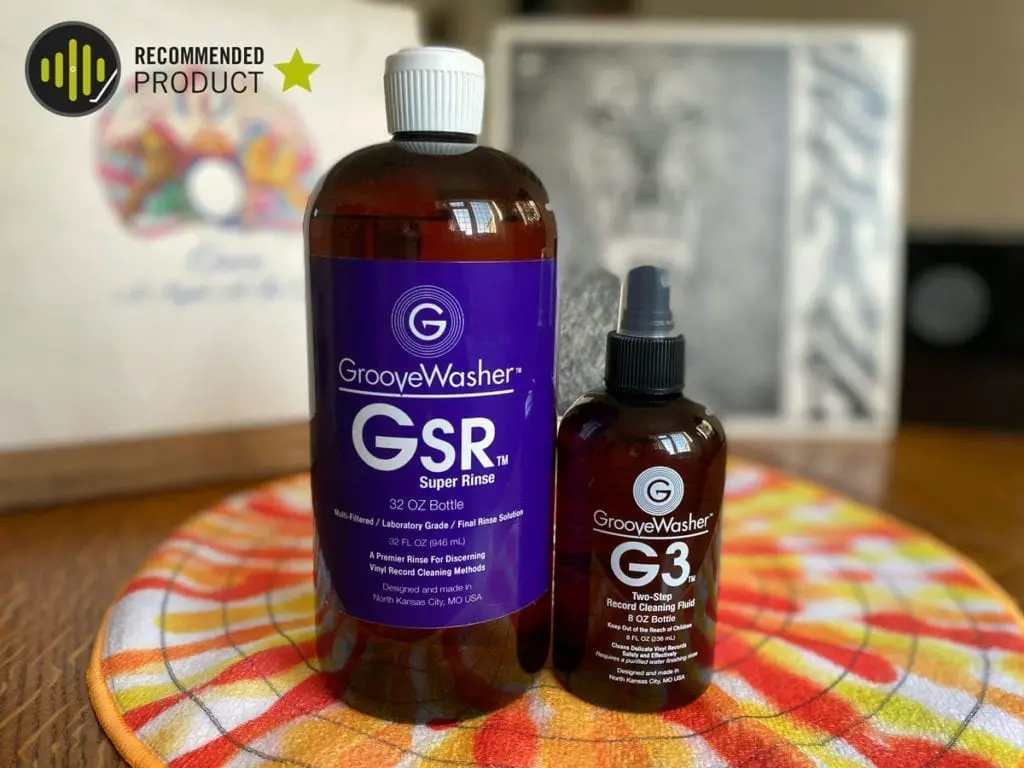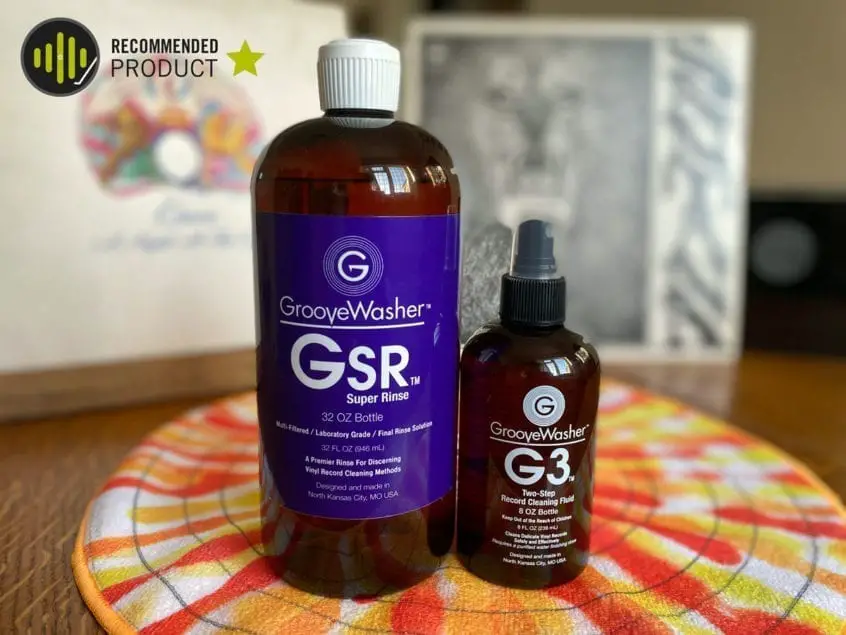The latest record cleaning formula from GrooveWasher gets down to work faster than their flagship G2 offering.

I’ve used GrooveWasher’s G2 as my main record cleaning solution for many years now.
The reason? It works.
It’s the perfect turntable companion and the best record cleaning fluid I’ve encountered for day-to-day use.
The team at GrooveWasher are anything if dedicated. The G2 fluid was carefully developed in their lab as a one-step cleaning fluid capable of lifting oils, dirt, mildew, and dust particles without risking damage to the record surface.
For most records, G2 is perfect. It’s effective yet gentle. But what about those dirtier records? Records with years of neglect – perhaps they’ve been left out of the sleeve regularly, handled carelessly, and likely, never cleaned by the previous owner.
G2 does a great job on these records, but you may need to clean the record several times to see a significant result. (Check out our full review of G2 with audio samples to see and hear what I mean).
As a matter of caution, I always like to use the gentlest cleaning method possible to achieve the result. After all, why use a sledgehammer to kill a fly?
There are, however, circumstances where it makes sense to up the fluid strength. Enter G3 – GrooveWasher’s new stronger cleaning fluid—designed specifically for bringing those unloved, dirtier records back to life.
What Makes the New G3 Fluid Different?
The new G3 fluid is the same formula as the one-step G2 Fluid we know and love, but with an increased surfactant concentration for greater cleaning power. The trade-off for turning up the power is you will need to perform a second rinse stage.
What’s in the Fluid?
For obvious reasons, all record cleaning producers keep their products’ exact recipes close to their chest. However, GrooveWasher are more transparent than most when it comes to explaining how their fluids work.
Here’s the basic formula broken down:
Surfactants: These are detergents that help dissolve and suspend fingerprints and oily grime.
Super wetting agent: This reduces the surface tension of the record cleaner, helping it reach the bottom of the groove. You’ll notice how GrooveWasher fluids behave differently on the record surface compared to pure distilled water. Spray and watch as the fluid spreads down the grooves.
Emulsifiers: These hold the oils, dirt, mildew, and dust particles in suspension. When you apply the microfiber fabric cleaning pad, the dirt-filled solution is lifted from the record surface.
Laboratory grade, double deionized, carbon filtered & UV treated water: You don’t want to apply anything other than purified water to your records, particularly if you live in a hard water area. GrooveWasher sources the best lab-grade water as the carrier for active cleaning ingredients.
G3 On Test: Does it Work?
Now for the part you’ve all been waiting for and the reason you’re probably reading this review. Does it work?
I picked up three used records from Discogs to test the new G3: a copy of Santana’s first album, and two Queen albums (A Night at the Opera and Sheer Heart Attack).
I always like to pick up a few records for testing as you never know how dirty a used record will be until it arrives. Sometimes I’ll get lucky and the record is pretty clean, and on other occasions, the record is laden with decades of dust, dirt and grime. It’s the nature of the beast, but it gives me a good excuse to buy more records. What can I say, it’s a tough job, but someone’s got to do it!
Sheer Heart Attack was actually pretty decent and would clean up with a little G2, no problem. A Night at The Opera, on the other hand, was a different story altogether. Very dirty; pops and crackles for days! Santana was somewhere in the middle. It sounded pretty clean to start, but the stylus was plowing a lot of dust, and would clog up fairly quickly.
With that said, A Night at The Opera is the main test subject for this review. As you can hear from the samples below, the record was very dirty right out of the sleeve and clearly hadn’t been cleaned in a long time, if ever. It’s a 1975 copy and part of the first round of pressings (run-out groove reads):
(A): YAX 5063-2
(B): YAX 5064-2
Both sides have “BLAIR’S” to represent Chris Blair the Abbey Road mastering engineer for this album.
So by my estimation, this record hasn’t been cleaned since it was originally bought in 1975. I took this record away from the turntable to clean on GrooveWasher’s landing towel (these come supplied with a GrooveWasher Mondo kit, but you can also use a large, clean microfiber cloth if you don’t have one).
It’s best to clean away from the turntable when performing anything more than a light groom of the record. Very dirty records may require a little more fluid, and in this case we also have the second rinse stage. You don’t want fluid pouring all over your deck!
I applied the G3 fluid in the same way I would apply G2, and for this stage I used the normal GrooveWasher walnut handled pad.
For the second rinse stage, I found it helpful to have a separate microfiber cloth to keep the two fluids separate. We want this second stage to remove any of the remaining G3 fluid, so it makes sense to use a separate cloth in this case. For a nicer finish, you can also use a fine microfiber finishing towel.
The first clean shows a significant reduction in crackles, and due to the record’s clear-cut transitions from quiet to loud, it’s very easy to hear the underlying surface noise.
Very impressive for a single clean on such a dirty record. I’m sure it would’ve taken more than one clean to achieve this with the milder G2.
I was curious, though, would a second clean show further improvement still?
The second time around, I left the fluid on for much longer, giving the detergents and emulsifiers longer to do the heavy lifting.
The result was another audible improvement, albeit more subtle this time. At this stage, I’m convinced this is as good as it gets for this record, which was likely played dirty for many years. Ultrasonic cleaning might see a further improvement, but that remains a test for another day.
As for Santana, well, here are the results. One clean with G3 was enough to bring this terrific copy back to near-new sounding condition. Happy days!
Using G3 with a Record Cleaning Machine
GrooveWasher state that you can confidently use G3 with vacuum-based record cleaning machines. This will give you the added advantage of sucking the dirty fluid directly off the record surface. You can, however, ensure the effectiveness of a microfiber cloth or pad by cleaning and replacing them regularly. Watch this space for a full overview of G3 using a record cleaning machine in the near future.
The Bottom Line
The new G3 fluid is another winner from GrooveWasher. G2 remains my day-to-day turntable companion for record cleaning, while the G3 will now take center-stage for very dirty used records. GrooveWasher customers called for a slightly stronger version of G2 for this very purpose, and being a customer-driven business, the team listened and delivered. Clearly, there is no such thing as a one-size-fits-all solution for cleaning records, and so I can see further developments coming out of the GrooveWasher lab in the months and years to come. If you regularly pick up used records, you need G3 in your toolkit.
(Sound Matters readers receive 10% off direct orders from GrooveWasher when using the discount code: SOUNDMATTERS10)










How would g3 compare to using tergikleen for very dirty / noisy records?